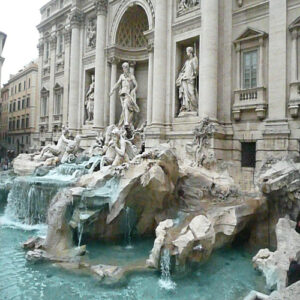- Feb 3, 2024
- LitBits
- 0
Just posted on SuperStack by Eva Ulian – discussions in this thread, please
---

Central figure: god Ocean, flanked by horses and Tritons, sons of sea god
Niches: Fig left: Abundance Fig right: Health
Walk through the heart of Rome and you will be lured in one direction and then another as instantaneously as a magnet does with a piece of iron… The Pantheon will attract you with its metaphysical force of the gods, the Foro Imperiale with its magnitude of power… while the Fountain of Trevi will spark off the imagination towards lingering of Romance. It will fire visions of cupids and arrows, star-struck lovers and dreamy devotees wearing rose-coloured glasses… sheer magic!
The Fountain of Trevi, like other monuments is only made up of rocks, stone, statues and water, yet these shapes and forms seem to hold some kind of unseen fascination that have attracted not only people from far and wide but film producers who have made the fountain a central theme in films like “la Dolce Vita”, “Three Coins in a Fountain” and “Roman Holiday”.
The origins of the fountain can be traced back to the aqueduct called “Acqua Virgo” (Virgin Waters) constructed in the year 19 Before Christ by General Agrippa to bring water to his baths and who was favourited by Emperor Ocativian Augustus. It is said this came about because a Shepherdess leads him to this spring to give water to his thirsty soldiers. Therefore the two basic founders of this fountain are the Shepherdess and General Agrippa. I highlight this point because it plays a significant role in the development of the fountain.
You would think that they who are responsible for bringing into being this monument could claim a predominant place in the allocation of personages that populate the fountain. Initially this was to be so since Gian-Lorenzo Bernini , commissioned by Pope Urban VIII (1623-1644) re-orientated the fountain from its original position to where it is today had predisposed a central place for the figures of Agrippa and the Shepherdess, one at each side of the central and dominating figure the god Ocean who is the personification of an immense river which flows around the earth and from which the stream of water originate.
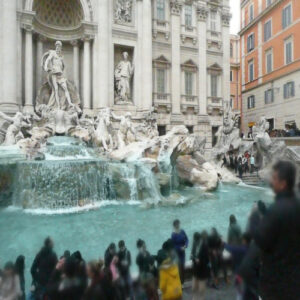
Meeting point of the third street – on right.
But Bernini’s fountain did not come into being having lost favour with subsequent pontificates. However in 1730, a hundred years later, Pope Clement XII (1730-1740) decided to rebuild the existing fountain and after a competition he selected Nicolò Salvi’s project plan because its grandeur would outshine in beauty and splendor any other fountain in Rome. Unfortunately in 1744, Salvi was hit with partial paralysis. Even so the work continued and the two sea-horses guided each by a triton which in Greek mythology were the sons of the god of the sea, Poseidon, and Amphitrite and are represented as having the head and torso of a man but the tail of a fish, hence a mer-man, using a conch-shell for a trumpet , were installed. Salvi also added innumerable amounts of flora and fauna to populate the fountain, fig-leaves, grape-vine, marigold and so on are strewn around the fountain almost unnoticeable to the tourist’s eye while a stone lizard or snail will creep out, unaware, from the many crevices and fissures of the fountain.
When Salvi died in 1751 the task to complete the work was given to Giuseppe Pannini under the Pontificate of Pope Clement XIII (1758–1769) who finished the work in 1772 but not without making some, what I consider, vital changes and will be explained in Part 2 of this article.
In the niche on either side of the central figure the god Ocean there stands on the left the goddess of Abundance and on the right the goddess of Health. In those niches Salvi had placed the two fundamental figures which are the basis of the fountain, General Agrippa (on the left) and the Shepherdess leading his soldiers to the spring on the other side. Pannini relegated General Agrippa to a bas-relief above the statue of Abundance and the Shepherdess to a bas-relief on the other side above Salubrity (Health).
This says a lot on what the powerful of the times (Pope Clement XIII 1758-1769) considered to be of greater importance, the individual or the ideal- obviously, the ideal took place over the individual, completely reversing what artists like Michelangelo during the Renaissance had tried to establish, that man is at the centre of the world not vice-versa.
This conception, that there are greater elements beyond mere man is inscribed and moulded on and in every piece of stone of the monument. The two horses represent the mood of the sea, from calm to disturbed and restless, led by their tritons which, half man, half fish are sons of the sea god himself, and it is they, not man who have power to dominate the sea, which in itself is a power that cannot be dominated, let alone by man. Behind them, on the left, the goddess of Abundance shows how dependent man is on wealth and other external needs; while without the aid of the goddess of Salubrity , on the right, man can do nothing if he is without this goddess- health.
This idea that man is a beggar to greater elements is repeated on the attic by the representation of four other goddesses: she who is The Abundance of Fruits, The Fertility of the Fields, The Gifts of Autumn and The Amenity of the Grasslands- all elements without which man will starve, die and at the best, live a life only of want and misery.
However, if man was considered a lesser being than the elements which surrounded him, Pope Clement XII did not consider this to apply to him personally because, as if a crown to the entire façade we have his papal insignia and family shield all wondrously flanked by two angels, sounding their trumpets which are symbols of fame and glory. Pope Clement is also desirous to leave future generations in no doubt when and who had been responsible for enacting this great wonder by the following inscription which has been translated from Latin:

Translation: Clement XII, the Supreme Pontiff has embellished with splendid refinement the Virgin Water, esteemed for its abundance and wholesomeness, in the year of the Lord 1735, sixth of his office.”
However, Pope Clement XII was more indulgent in favour of showering bounty unto mankind since it was his successor, Clement XIII who covered up the genitals of the male statues in the Vatican from which we can imagine to what level he considered mankind to be, no wonder he supplanted the human figures with those of goddesses.
When we consider that the whole concept of this fountain is based on the happiness, comfort and wealth of mankind being dependent and subordinate on the gifts which are poured upon him from beyond himself… In times of crises like the present, is it not a comforting thought to dwell upon?
---
By @Eva Ulian
Get the discussion going – post your thoughts & comments in the thread below…
---

Central figure: god Ocean, flanked by horses and Tritons, sons of sea god
Niches: Fig left: Abundance Fig right: Health
PART ONE
Walk through the heart of Rome and you will be lured in one direction and then another as instantaneously as a magnet does with a piece of iron… The Pantheon will attract you with its metaphysical force of the gods, the Foro Imperiale with its magnitude of power… while the Fountain of Trevi will spark off the imagination towards lingering of Romance. It will fire visions of cupids and arrows, star-struck lovers and dreamy devotees wearing rose-coloured glasses… sheer magic!
The Fountain of Trevi, like other monuments is only made up of rocks, stone, statues and water, yet these shapes and forms seem to hold some kind of unseen fascination that have attracted not only people from far and wide but film producers who have made the fountain a central theme in films like “la Dolce Vita”, “Three Coins in a Fountain” and “Roman Holiday”.

Trevi: the name probably derives from tribus (three) the meeting of the three main streets in Rome – the first two on left
So let’s take a look to see what in fact these shapes and forms made of stone represent.
The origins of the fountain can be traced back to the aqueduct called “Acqua Virgo” (Virgin Waters) constructed in the year 19 Before Christ by General Agrippa to bring water to his baths and who was favourited by Emperor Ocativian Augustus. It is said this came about because a Shepherdess leads him to this spring to give water to his thirsty soldiers. Therefore the two basic founders of this fountain are the Shepherdess and General Agrippa. I highlight this point because it plays a significant role in the development of the fountain.
You would think that they who are responsible for bringing into being this monument could claim a predominant place in the allocation of personages that populate the fountain. Initially this was to be so since Gian-Lorenzo Bernini , commissioned by Pope Urban VIII (1623-1644) re-orientated the fountain from its original position to where it is today had predisposed a central place for the figures of Agrippa and the Shepherdess, one at each side of the central and dominating figure the god Ocean who is the personification of an immense river which flows around the earth and from which the stream of water originate.

Meeting point of the third street – on right.
But Bernini’s fountain did not come into being having lost favour with subsequent pontificates. However in 1730, a hundred years later, Pope Clement XII (1730-1740) decided to rebuild the existing fountain and after a competition he selected Nicolò Salvi’s project plan because its grandeur would outshine in beauty and splendor any other fountain in Rome. Unfortunately in 1744, Salvi was hit with partial paralysis. Even so the work continued and the two sea-horses guided each by a triton which in Greek mythology were the sons of the god of the sea, Poseidon, and Amphitrite and are represented as having the head and torso of a man but the tail of a fish, hence a mer-man, using a conch-shell for a trumpet , were installed. Salvi also added innumerable amounts of flora and fauna to populate the fountain, fig-leaves, grape-vine, marigold and so on are strewn around the fountain almost unnoticeable to the tourist’s eye while a stone lizard or snail will creep out, unaware, from the many crevices and fissures of the fountain.
When Salvi died in 1751 the task to complete the work was given to Giuseppe Pannini under the Pontificate of Pope Clement XIII (1758–1769) who finished the work in 1772 but not without making some, what I consider, vital changes and will be explained in Part 2 of this article.
PART TWO
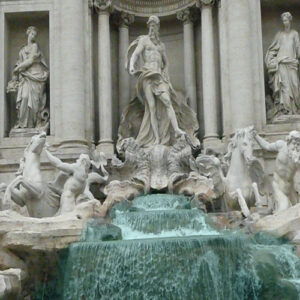
Abundance and Health on either side of Ocean
In the niche on either side of the central figure the god Ocean there stands on the left the goddess of Abundance and on the right the goddess of Health. In those niches Salvi had placed the two fundamental figures which are the basis of the fountain, General Agrippa (on the left) and the Shepherdess leading his soldiers to the spring on the other side. Pannini relegated General Agrippa to a bas-relief above the statue of Abundance and the Shepherdess to a bas-relief on the other side above Salubrity (Health).
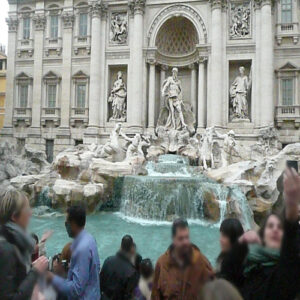
Abundance and Health on either side of Ocean
Bas-relief: Agrippa on left and Shepherdess on right
This says a lot on what the powerful of the times (Pope Clement XIII 1758-1769) considered to be of greater importance, the individual or the ideal- obviously, the ideal took place over the individual, completely reversing what artists like Michelangelo during the Renaissance had tried to establish, that man is at the centre of the world not vice-versa.
This conception, that there are greater elements beyond mere man is inscribed and moulded on and in every piece of stone of the monument. The two horses represent the mood of the sea, from calm to disturbed and restless, led by their tritons which, half man, half fish are sons of the sea god himself, and it is they, not man who have power to dominate the sea, which in itself is a power that cannot be dominated, let alone by man. Behind them, on the left, the goddess of Abundance shows how dependent man is on wealth and other external needs; while without the aid of the goddess of Salubrity , on the right, man can do nothing if he is without this goddess- health.
This idea that man is a beggar to greater elements is repeated on the attic by the representation of four other goddesses: she who is The Abundance of Fruits, The Fertility of the Fields, The Gifts of Autumn and The Amenity of the Grasslands- all elements without which man will starve, die and at the best, live a life only of want and misery.
However, if man was considered a lesser being than the elements which surrounded him, Pope Clement XII did not consider this to apply to him personally because, as if a crown to the entire façade we have his papal insignia and family shield all wondrously flanked by two angels, sounding their trumpets which are symbols of fame and glory. Pope Clement is also desirous to leave future generations in no doubt when and who had been responsible for enacting this great wonder by the following inscription which has been translated from Latin:

Translation: Clement XII, the Supreme Pontiff has embellished with splendid refinement the Virgin Water, esteemed for its abundance and wholesomeness, in the year of the Lord 1735, sixth of his office.”
However, Pope Clement XII was more indulgent in favour of showering bounty unto mankind since it was his successor, Clement XIII who covered up the genitals of the male statues in the Vatican from which we can imagine to what level he considered mankind to be, no wonder he supplanted the human figures with those of goddesses.
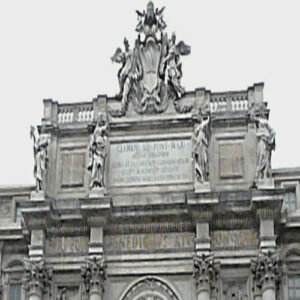
The four goddesses on attic on either side of the inscription
When we consider that the whole concept of this fountain is based on the happiness, comfort and wealth of mankind being dependent and subordinate on the gifts which are poured upon him from beyond himself… In times of crises like the present, is it not a comforting thought to dwell upon?
---
By @Eva Ulian
Get the discussion going – post your thoughts & comments in the thread below…

